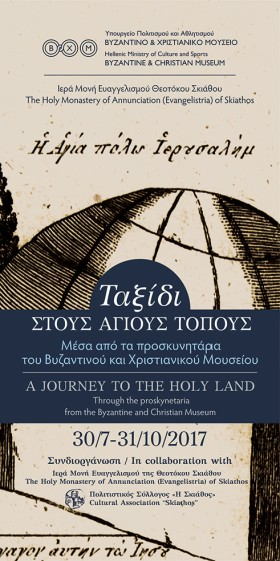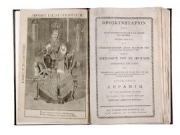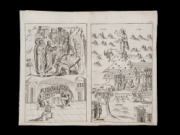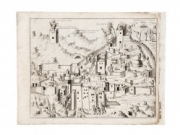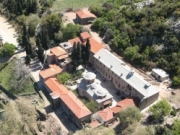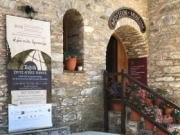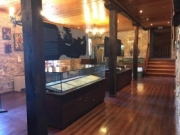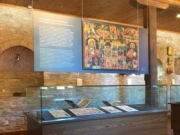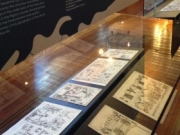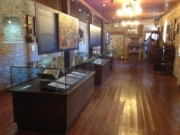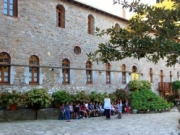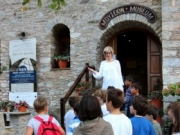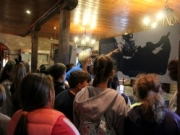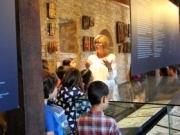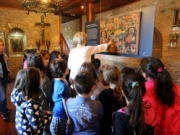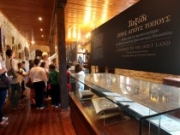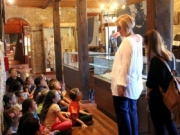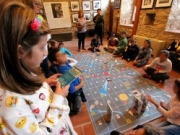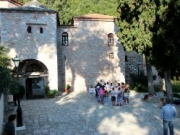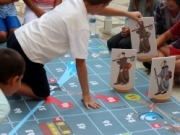at the museum of the Holy Monastery of Annunciation (Evangelistria) of Skiathos
29 July 2017 until 31 October 2017
In more recent times, beginning in the 16th century and culminating in the period between the 17th and 19th century, systematic information regarding the holy pilgrimage sites that must not be missed by the visitor are given in manuscript and printed proskynetaria (pilgrim’s guides) to the Holy Land. These travel guides, usually illustrated, are intended for Orthodox Christians and contain information regarding the stations in Christ’s earthly life and Passion. The illustrations of the Proskynetaria mark spatial entities which serve as a map of the holy shrines, a holy geography of the places through which Christ passed during his earthly life.
Most Orthodox pilgrims preferred the safer route by sea. The duration of the pilgrimage depended on the traveler’s financial position, lasting from three months to one year, and coincided with the celebration of Easter. It is worth noting that the sea voyage aboard the sailing ships of the 17th and 18th century would have taken up to five months. The time required depended on the type of ship, the weather conditions throughout the duration of the journey and any chance problems that might arise, and significantly, on the route taken by the mainly commercial ships upon which the pilgrims booked passage.
The most important pilgrimage destination in the Holy Land is Jerusalem. It is here that the main monument of Christianity is located: the Holy Sepulchre. It is followed in significance by the churches and monasteries in and around Jerusalem, as well as the shrines in the wider area of the Holy Land, which are described and illustrated in detail in the Pilgrim’s Guides (Proskynetaria) of the 17th – 19th c.
In printed proskynetaria, the city of Jerusalem is commonly rendered as walled and sitting atop the peak of a hill, following the Byzantine tradition. More rarely it is developed longitudinally and bears standard morphological elements of the city. Jerusalem is the archetype city, the city chosen by the Lord as his residence from the time of the Old Testament, the city in which the first Church was founded. Earthly Jerusalem is identified in Christian thought with Heavenly Jerusalem, serving as an image of the Divine Kingdom on earth and completing the image of the Christian emperor’s reign by the grace of God.
The most significant Christian monument of worship in Jerusalem is the composite building complex of the Holy Sepulchre, with its numerous individual shrines. The ground plan presented in the printed proskynetaria contains detailed annotations of all its shrines.
During the 18th-19th c. painted proskynetaria make their appearance, souvenirs from the Holy Land brought home by pilgrims. These painted representations depict an abbreviated Christian topography of the Holy Land, making them important documentation of the journey of each pilgrim. Easily transported in a cylindrical roll, the proskynetaria function as illustrated guides to the shrines, or as we might say, “snapshots” of the trip, maintaining a spiritual connection to Jerusalem for home worship.
In conjunction with the exhibition “A journey to the Holy Land, through the 17th – 18th century proskynetaria from the Byzantine and Christian Museum” the educational program “From Land to Land” was presented in the Evangelistria Monastery Museum, Skiathos Island, from September 27th to September 29th.
The educational program was attended by more than 200 students of Skiathos Elementary schools, who also participated in a floor game of “snakes and ladders” type, following the pilgrim paths to the Holy Land.
GENERAL COORDINATION
dr Katerina P. Dellaporta
Director of the Byzantine and Christian Museum
EXHIBITION CURATOR - TEXTS: dr Antonis Bekiaris, archaeologist (BCM)
MUSEOGRAPHICAL DESIGN: Spyros Nasainas, architect
CONSERVATION:
Georgia Doskari, Angeliki Kalamitsi (paintings) (BCM)
Artemis Kampouraki, Vaso Papakosta, Ioanna Stefani (paper) (BCM)
GRAPHIC DESIGN: Yorgos Soupios, Yannis Stavrinos (BCM)
PHOTOGRAPHS: Nikos Mylonas (BCM)
TRANSLATION: Freya Rain Evenson
TECHNICAL SUPPORT: Yorgos Korkovelos (BCM)
DIGITAL PRINTINGS: Nikos Paskalidis
BROCHURE PRINTINGS: Dounias S.A.









